Chapter Four
Dangerous Concept, Dangerous Times - Galileo, Kepler and the Church: The Prince Astronomer, Tycho Brahe
"The loss of body parts has always fascinated me. I run across many such cases in my study of early modern medicine. Tycho Brahe, better known for his astronomical interests, is one of the more famous victims. As a youth of the Danish nobility, he was permitted to carry a sword and had a habit of using it in tavern brawls. In one such incident he failed to parry and paid with his nose, clipped right up to the septum."— The Collected Noses of Tycho Brahe by J. R. Salling
Tycho Brahe ∫∫∫
 The beginning of the 17th century saw the zenith for observational astronomy, marking the end of "naked-eye" research. Yet, as the 16th century came to a close, it still had one additional and lasting acheivement to leave science. As noted by editor Christina J. Moose in the article Tycho Brahe:
The beginning of the 17th century saw the zenith for observational astronomy, marking the end of "naked-eye" research. Yet, as the 16th century came to a close, it still had one additional and lasting acheivement to leave science. As noted by editor Christina J. Moose in the article Tycho Brahe:"Brahe's observatories on the island of Hveen represented the state of the art in sixteenth century astronomical observations. Here he gazed at the stars, recorded his observations, made his mathematical computations, and had his most famous instruments built and installed: three equatorial armillae; a mural quadrant, which he used to determine time; and sextants with transversals on the graduated arc and improved sights that allowed for pointing the instrument with great precision to measure distances and angles." Image of Tycho's Medium sized Azimuth quadrant of brass from BibliOdyssey: Tycho Mechanica. [18]
As previously mentioned, Tycho left Leipzig University in 1565 and returned to his home in Copenhagen. He didn't remain long however, finding himself ready to leave after receiving a less then cordial reception from his family on account of his decision to become a student of science rather than law. In fact, the only family encouragment in his endeavour to pursue astronomy seems to have come from his uncle, Steen Bille, who believed it a much wiser choice to allow Tycho to follow his own inclinations in the matter, later providing Tycho with help in constructing an observatory and alchemy laboratory in Herrevad Abbey. After the death of his uncle, Jorgen brahe, there was little to keep Tycho at home and so in 1566, he travelled to Germany, arriving at both the city and University of Wittenberg in April of that year. [19]
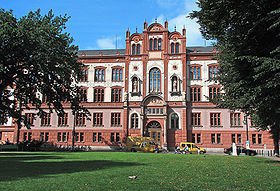 Though a leading university at the time, little is known of Tycho's movements while at the University of Wittenberg other than that his stay there was very short. As a result of an outbreak of plauge, Tycho was naturally inclined to leave, doing so in September of that same year, having spent only five months at the university. He arrived at the city of Rostock at the beginning of September and was admitted to the university there on the 24th of that month. But as this university did not have an acemdemic venue for the science of astronomy, Tycho's enrollement there must have been more a matter of where to go in a hurry then a carefully thought out decision in pursuit of his choosen discipline. Whatever the case may have been, the end of 1566 saw the occurrence of two events that give us both insight into a lesser known aspect of his talents and another, of his character. Image: University of Rostock's Central building from Wikipedia [20] fn1
Though a leading university at the time, little is known of Tycho's movements while at the University of Wittenberg other than that his stay there was very short. As a result of an outbreak of plauge, Tycho was naturally inclined to leave, doing so in September of that same year, having spent only five months at the university. He arrived at the city of Rostock at the beginning of September and was admitted to the university there on the 24th of that month. But as this university did not have an acemdemic venue for the science of astronomy, Tycho's enrollement there must have been more a matter of where to go in a hurry then a carefully thought out decision in pursuit of his choosen discipline. Whatever the case may have been, the end of 1566 saw the occurrence of two events that give us both insight into a lesser known aspect of his talents and another, of his character. Image: University of Rostock's Central building from Wikipedia [20] fn1Witnessing a lunar eclispe on October 28th, 1566 Tycho predicted that it foretold the death of the Turkish Sultan Soliman, an event which came to pass. "What is often forgotten, or simply ignored by historians of science, was that Brahe was also a mundane astrologer. Mundane astrology studies the charts of nations that are read much as are charts of individuals." [21]
There was but one drawback to Tycho's prediction. the Sultan Soliman had died prior to the occurrence of the lunar eclispe, having fallen during the seige of the Hungarian fortress of Szigetvár ( Szigeth ) on September 6th. Despite some sneering over the timing of his prediction, Tycho was able to explain it away. But in December of that year, he became involved in an incident which left him with some very uncomfortable results — for the rest of his life. [22]
Tycho Brahe's Nose — 1566 ∫∫∫
One may not think a man of science to have much of a temper, but Tycho became famous for his. It was a character trait that has given history its second most famous aspect on the life of Tycho Brahe.
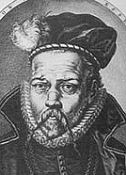 If anything can be said regarding the incident in whcih Tycho lost part of his nose, it is that the duel in which it occurred has become as well known and recorded as is his extremely accurate records of naked-eye star observations and the second most notable and written fact about Tycho. The story's notoriety and longevity is all the more interesting in that the incident lasted, at most, a minute, its history usually over and done with in less than a paragraph and in a few writings, it appears only as a footnote. At left is a portrait of Tycho Brahe clearly showing his damaged nose. Additional portraits of Tycho can be found at the MacTutor History of Mathematics website at the University of St. Andrews in Scotland.
If anything can be said regarding the incident in whcih Tycho lost part of his nose, it is that the duel in which it occurred has become as well known and recorded as is his extremely accurate records of naked-eye star observations and the second most notable and written fact about Tycho. The story's notoriety and longevity is all the more interesting in that the incident lasted, at most, a minute, its history usually over and done with in less than a paragraph and in a few writings, it appears only as a footnote. At left is a portrait of Tycho Brahe clearly showing his damaged nose. Additional portraits of Tycho can be found at the MacTutor History of Mathematics website at the University of St. Andrews in Scotland.The actual "duel" was a rather simple and strightforward affair and was related by Cecil Adams in 1998 in an online article Did astronomer Tycho Brahe really have a silver nose? from the The Straight Dope website:
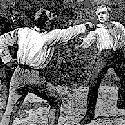 "It happened in 1566 while the 20-year-old Tycho was studying at the University of Rostock in Germany. Attending a dance at a professor's house, he got into a quarrel with one Manderup Parsbjerg, like himself a member of the Danish gentry. Over a woman? Nah--tradition has it that the two were fighting over some fine point of mathematics. (My guess: Fermat's Next-to-Last Theorem, which posits that 2 + 2 = 5 for very large values of 2.) Friends separated them, but they got into it again at a Christmas party a couple weeks later and decided to take it outside in the form of a duel. Unfortunately for Tycho the duel was conducted in pitch darkness with swords. Parsbjerg, a little quicker off the dime, succeeded in slicing off the bridge (apparently) of Tycho's nose." [23]
"It happened in 1566 while the 20-year-old Tycho was studying at the University of Rostock in Germany. Attending a dance at a professor's house, he got into a quarrel with one Manderup Parsbjerg, like himself a member of the Danish gentry. Over a woman? Nah--tradition has it that the two were fighting over some fine point of mathematics. (My guess: Fermat's Next-to-Last Theorem, which posits that 2 + 2 = 5 for very large values of 2.) Friends separated them, but they got into it again at a Christmas party a couple weeks later and decided to take it outside in the form of a duel. Unfortunately for Tycho the duel was conducted in pitch darkness with swords. Parsbjerg, a little quicker off the dime, succeeded in slicing off the bridge (apparently) of Tycho's nose." [23]An account of the duel can also be found in the latin written "Tycho Brahe, the man and his work", by Pierre Gassendi, 1654 which was translated to swedish and commented by Wilhelm Norlind, 1951. Writes Gassendi:
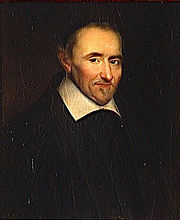 "The 10th of december 1566 there was a dance at Lucas Bacmeisters house in the connection to a wedding. Lucas Bacmeister was a professor of theology at the univeristy of Rostock where Tycho studied. Among the guests were Tycho Brahe and another danish nobleman, Manderup Parsberg. They started an argument and they separated in anger. The 27th of december this argument started again, and in the evening of the 29th of december a duel was held. It was around 7 in the evening and in darkness. Parsberg gives Tycho a cut over his nose that took away almost the front part of his nose. Tycho had an artificial nose made, not from wax, but from an alloy of gold and silver and put it on so skillfully, that it looked like a real nose Wilhelm Janszoon Blaeu, who spent time with Tycho for nearly two years, also said that Tycho used to carry a small box with a paste or glue, with which he often would put on the nose." Image left: Pierre Gassendi, painted by Louis Édouard Rioult. [24] fn2
"The 10th of december 1566 there was a dance at Lucas Bacmeisters house in the connection to a wedding. Lucas Bacmeister was a professor of theology at the univeristy of Rostock where Tycho studied. Among the guests were Tycho Brahe and another danish nobleman, Manderup Parsberg. They started an argument and they separated in anger. The 27th of december this argument started again, and in the evening of the 29th of december a duel was held. It was around 7 in the evening and in darkness. Parsberg gives Tycho a cut over his nose that took away almost the front part of his nose. Tycho had an artificial nose made, not from wax, but from an alloy of gold and silver and put it on so skillfully, that it looked like a real nose Wilhelm Janszoon Blaeu, who spent time with Tycho for nearly two years, also said that Tycho used to carry a small box with a paste or glue, with which he often would put on the nose." Image left: Pierre Gassendi, painted by Louis Édouard Rioult. [24] fn2What is probably the most historically relevant outcome of this incident is that neither seemed to begrude the other in any way. The hostility between the two ended with the duel, Parsberg eventually becoming one of Tycho's major supporters under the Danish King Christian IV. Tycho Brahe, 1566 to 1572 ∫∫∫
Between the end of 1566 and the beginning of 1572 Tycho moved about the European countryside quite a bit and while we do have recorded observations of his, a good deal of his history at this time is more the result of where he eventually showed up. What follows is a precis from J. L. E Dreyer's techinical biography on Tycho ( see 13 below ):
 In April of 1567 Tycho observed an eclipse of the sun which was "seven digits" at Rostock. Thereafter, in the summer of that year, Tycho returned home but doesn't seem to have received a very warm welcome and therefore was back at Rostock at the end of that year. fn3
In April of 1567 Tycho observed an eclipse of the sun which was "seven digits" at Rostock. Thereafter, in the summer of that year, Tycho returned home but doesn't seem to have received a very warm welcome and therefore was back at Rostock at the end of that year. fn3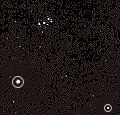 In 1568, having returned to Rostock, Tycho began almost immediately to make recorded observations. Since he was still bereft of any instruments at this time, Tycho had to be content with simply jotting down the positions of Jupiter and Saturn in relation to the stars. On May 14 he was given, under the hand of King Frederick II, a formal promise of the first vacant canonry. Towards the last portion of the year, Tycho returned to Wittenberg and was in Basle where he was enrolled at the University, remaining there until the early part of 1569.
In 1568, having returned to Rostock, Tycho began almost immediately to make recorded observations. Since he was still bereft of any instruments at this time, Tycho had to be content with simply jotting down the positions of Jupiter and Saturn in relation to the stars. On May 14 he was given, under the hand of King Frederick II, a formal promise of the first vacant canonry. Towards the last portion of the year, Tycho returned to Wittenberg and was in Basle where he was enrolled at the University, remaining there until the early part of 1569. Tycho eventually settled at Augsburg, the city most dear to Protestants at the time due to its position as center stage for that era's reform movement under the 1555 Peace of Augsburg settlement. It was here that saw Tycho constructed his first of many observing instrument; it was his opinion that those at hand were just too simple for accurate scientific purposes. In collaboration with Paul Hainzel, they built a large azimuthal quadrant ( used to measure the heigth of stars ) of about 19 feet, erecting the device on the top of a hill on Hainzel's estate in Göggingen, where it remained until destroyed by a storm in December of 1574. The quadrant was used to measure the "new star" ( supernova ) of 1572 and a handful of fixed stars.
Tycho eventually settled at Augsburg, the city most dear to Protestants at the time due to its position as center stage for that era's reform movement under the 1555 Peace of Augsburg settlement. It was here that saw Tycho constructed his first of many observing instrument; it was his opinion that those at hand were just too simple for accurate scientific purposes. In collaboration with Paul Hainzel, they built a large azimuthal quadrant ( used to measure the heigth of stars ) of about 19 feet, erecting the device on the top of a hill on Hainzel's estate in Göggingen, where it remained until destroyed by a storm in December of 1574. The quadrant was used to measure the "new star" ( supernova ) of 1572 and a handful of fixed stars.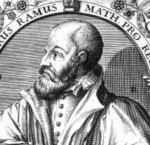 It was during this period that Tycho made the acquaintance of a few of the more notable and forward thinkers of his day. These included men like the educational reformer Pierre de la Ramée, astronomer Cyprianuis Leovitius, German historian and humanist Hieronymus Wolf, Philip Apianus, son of the famous author of Astronomicum Cæsareum, Pete Apianus and the German astronomer and the mayor of Augsburg Paul Hainzel and his brother Johannes Baptista Hainzel. Image right of Petrus Ramus ( Pierre de la Ramée ) from Wikipedia.
It was during this period that Tycho made the acquaintance of a few of the more notable and forward thinkers of his day. These included men like the educational reformer Pierre de la Ramée, astronomer Cyprianuis Leovitius, German historian and humanist Hieronymus Wolf, Philip Apianus, son of the famous author of Astronomicum Cæsareum, Pete Apianus and the German astronomer and the mayor of Augsburg Paul Hainzel and his brother Johannes Baptista Hainzel. Image right of Petrus Ramus ( Pierre de la Ramée ) from Wikipedia.
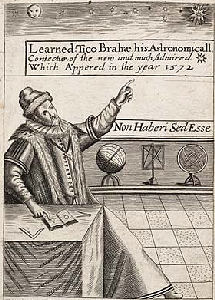 On November 11, 1572 Tycho was returning to his home when, looking up towards the constellation of Cassiopea he noticed a star where none had been before. Since he had just completed construction of a new sextant instrument, which had a much higher degree of accuracy than earlier cross-staff devices, he was able to measure the distance of the new object with the device using the known stars within Cassiopea. For Tycho, the appearence of the new star was most portentous and for the rest of his life no other single event would be more influential in shaping his path and career.
On November 11, 1572 Tycho was returning to his home when, looking up towards the constellation of Cassiopea he noticed a star where none had been before. Since he had just completed construction of a new sextant instrument, which had a much higher degree of accuracy than earlier cross-staff devices, he was able to measure the distance of the new object with the device using the known stars within Cassiopea. For Tycho, the appearence of the new star was most portentous and for the rest of his life no other single event would be more influential in shaping his path and career.In addition to the use of the new instrument he had built, he also came to realize that the science of astronomy was in sore need of exactly what he said it needed in 1563, "a long term project with the aim of mapping the heavens conducted from a single location over a period of several years." In addition, there was the publication of his small but famous book, "De nova stella" in 1573 that would gain Tycho the notice of those who were in the most favorable position to give him the resources he most needed in order to begin his observations; though he probably had no idea just how much his book would actually accomplish in this respect. The appearence of this star ( supernova ) was certainly a watershed in Tycho's career, as Christina J. Moose notes:
"Brahe concentrated his early studies on the apparent movements of the planets and the fixed stars. His father's death and an appointment as cantor of the Roskilde Cathedral devoured much of his time, but he steadfastly continued his work. His growing fame changed the attitudes of his family and peers toward his work: His uncle Steen Brahe had a lab outfitted for him. His first major breakthrough was the observation of a new star, first seen on November 11, 1572. The star, which he appropriately called Stella Nova in a book entitled De nova et nullius aevi memoria prius visa stella (1573; about the new star), appeared in the Cassiopeia constellation." — Great Lives from History: The Renaissance & Early Modern Era. Image above left is from the english reprinting (1632) of Tycho Brahe's De nova stella, originally published in Copenhagen in 1573. It is one of the two additional images added to this version of his book and shows Tycho pointing to his "new star". [25]
Tycho was, however, reluctant to publish his observations on the new star, due in no small measure to the fact that it was perceived as beneath a noble to write books; Tycho also indicated this prejudice among his peers as a reason for not going to publication. Another was his developing desire for secrecy, a trait that Tycho was now beginning to show. Keeping his data "secret" was one of the reason behind the later frustration and friction between Kepler and himself. It wasn't until his second return to Copenhagen that he was persuaded to publish his work by several friends including Peter Oxe, who was the High Treasurer of Denmark and related to Tycho. Oxes' sister was the wife of Jorgen Brahe and was therefore a second mother to Tycho. [26]
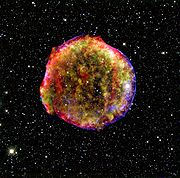 A further reason that nudged Tycho pass his reluctance to publish was the fact that the new star had also been observed by astronomers and astrologers alike, having been written about by many of the existing "scientific community" around Europe; several so badly in error of the stars position one wonders if they ever saw it at all. As these commentaries on the new star came to his attention, Tycho realized how far off the mark most were. The result of this conclusion was a strongly worded criticism of his contemporaries at the time, found in his preface to de Nova Stella, "O crassa ingenia. O caecos coeli spectatores" which translates to "Oh thick wits. Oh blind watchers of the sky"
A further reason that nudged Tycho pass his reluctance to publish was the fact that the new star had also been observed by astronomers and astrologers alike, having been written about by many of the existing "scientific community" around Europe; several so badly in error of the stars position one wonders if they ever saw it at all. As these commentaries on the new star came to his attention, Tycho realized how far off the mark most were. The result of this conclusion was a strongly worded criticism of his contemporaries at the time, found in his preface to de Nova Stella, "O crassa ingenia. O caecos coeli spectatores" which translates to "Oh thick wits. Oh blind watchers of the sky"de Nova Stella was initially printed in small quanities and saw little distribution (though it was well received by those to whom it mattered, gaining Tycho a measure of fame) until it was reprinted in at least two further works, a 1632 English printed translation of De nova stella titled Learned Tico Brahae his Astronomicall coniectur in which were added two additional images ( one shown above ) and a facsimile of which was produced in 1901, as a tercentenary tribute to the authors memory; the book is also responsible for having coined the term "nova" Image above of Supernova Remnant 1572 from NASA/MPIA/Calar Alto Observatory, Oliver Krause et al.
There were several profound and lasting results from the publication of Stella Nova, aside from the fame it brought Tycho. First was the determination he now held to begin setting the world of astronomy to rights and secondly, the publication's own inherent blow to the world as it was then viewed by the church and others at that time. "Tycho discovered that the new star did not shift its position with respect to the other stars, and therefore it really was a star. Since conventional opinion held that the heavens were perfect and unchanging, this was quit a shock, but Tycho's evidence was so convincing that his treatise marked the beginning of the end of the doctrine of the immutability of the heavens." — from the Linda Hall Library of Science, Engineering, & Technology
Meanwhile, Tycho's personal life also changed during 1572.
"In 1572, in Knudstrup, Tycho fell in love with Kirsten [Barbara] Jørgensdatter, a commoner whose father, Pastor Jorgen Hansen, was the Lutheran clergyman of Knudstrup's village church. Under Danish law, when a nobleman and a common woman lived together openly as husband and wife, and she wore the keys to the household at her belt like any true wife, their alliance became a binding morganatic marriage after three years. The husband retained his noble status and privileges; the wife remained a commoner. Their children were legitimate in the eyes of the law, but they were commoners like their mother and could not inherit their father's name, coat of arms, or land property." — Tycho Brahe - encyclopedia article - Citizendium [27]
Together, Tycho and Kirstine would have eight children: Kirstine, Magdalene, Claus, Sophie, Elisabeth, Sidsel, Tyge and Jörgen. It was a union that seemed truely to have been for love, lasting almost thirty years and entered into against the advice of friends who felt it beneath a noble to be in such a relationship.
Tycho Brahe ∫∫∫
 "He delivered lectures in Copenhagen by royal command in 1574; and in 1575 travelled through Germany to Venice. The execution of his design to settle at Basel was, however, anticipated by the munificence of Frederick II, king of Denmark, who bestowed upon him for life the island of Hveen in the Sound, together with a pension of 500 thalers, a canonry in the cathedral of Roskilde, and the income of an estate in Norway." from Tycho Brahe, NNDB website [28]
"He delivered lectures in Copenhagen by royal command in 1574; and in 1575 travelled through Germany to Venice. The execution of his design to settle at Basel was, however, anticipated by the munificence of Frederick II, king of Denmark, who bestowed upon him for life the island of Hveen in the Sound, together with a pension of 500 thalers, a canonry in the cathedral of Roskilde, and the income of an estate in Norway." from Tycho Brahe, NNDB website [28]Tycho's work was about to begin in earnest and its results would produce one of the most lasting legacies in the science of astronomy. It arrived in the form of meticulously recorded observations made from the island of Hven, revealed by the hand of another who's work would have an even larger influence upon 17th and 18th century science. All this would be accomplished using some of the most highly devloped instruments that European astronomy would see till the advent of the telescope in 1607. Image left: Island of Hven from Visualizing Tycho Brahe's Mars Data Website
Next Page Number 8 » UNDER CONSTRUCTION
Chapter Five of Galileo, Kepler and the Church — Finding the Character of Galileo, the Early Years
Footnotes
1. Dreyer also questions Tycho's decision to enroll at this particular university (Tycho Brahe, pp. 24-26) but reasons, with good cause, that the study of astrology, mathematics, alchemy and medicine were close enough to what Tycho required in pursuit of his goals to make going there worthwhile.
2. It is often mentioned that Tycho's nose was made of silver and gold and given his status and means, most appropriate. (see also Dreyer's Tycho Brahe, pp. 26-27 ). However, it is noted by some, such as Fredric Ihren and Cecil Adams ( see 22 & 23 below ) that the false nose also had copper. Ihren wrote that when Tycho's tomb was opened in 24 June 1901 green marks were found on his skull, suggesting copper. Cecil Adams also mentions this green colouring which was noted by the medical experts who examined the remains. Since copper is much lighter than gold and a tad less than silver one can only image the weight of a nose made solely of gold or silver. In a more light hearted writing on this subject, J. R Salling ( see 3 below ) notes: "Brahe was no peasant, nor did he ever think like one. I suspect he owned a nose for every occasion, which he glued into place with a temporary adhesive that he always carried with him. He made one himself of gold and silver but I have trouble imagining that he wore it often. Considering the weight, he must have feared it would pop off any time he laughed or sneezed, an especially embarrassing event at the table or at court."
3. Digit in astrophysics — used in expressing the amount of overlap of the Sun and the Moon in an eclipse. The "digit", as used herein, is equal to half the length of the apparent diameter, given that the two objects being virtually the same apparent size from Earth.












Chapter Four Bibliography
[1] Sewell, Kathy — from THE TABLE-TALK OF MARTIN LUTHER, TRANSLATED BY WILLIAM HAZLITT, Esq. Philadelphia: The Lutheran Publication Society, June 1, 1997 This book is in the public domain.
[2] Hatch, Dr Robert A. Kepler's Five Regular Solids, © 1999 Dr Robert A. Hatch - University of Florida
[3] Salling, J. R. The Collected Noses of Tycho Brahe, © 2009 Word Riot
[4] Wilson, John Wm. Johannes Kepler (1571-1630) Department of Physics and Astronomy Georgia State University, 20 November 2001.
[5] Tycho Brahe from Wikipedia — Revision history
[6] Tycho Brahe - encyclopedia article - Citizendium Article is quoting Wittendorff, ALex. 1994. Tyge Brahe. Copenhagen: G. E. C. Gad. The article is available under the Creative Commons-Attribution-ShareAlike 3.0 Unported license
[7] Curriculum vitae of Tycho Brahe from the Rundetaarn observatory website. RUNDETAARN Koebmagergade 52a DK-1150 Copenhagen Denmark
[8] Escutcheons of Science, Copyright © 2003-2009 by Gérard P. Michon, Ph.D. from the Escutcheons of Science - Armorial of Scientists - Numericana website, page Coat of arms of Tycho Brahe
[9] Tycho Brahe: Biography from Answers.com Wikipedia. This article is licensed under the GNU Free Documentation License. It uses material from the Wikipedia article "Tycho Brahe".
[10] Plant, David Skyscript: Tycho Brahe - A King Amongst Astronomers © by David Plant, This article was first published in The Traditional Astrologer Magazine, published by Ascella Publications, Issue 8, Spring 1995. Reprinting is by the kind permission of David Plant
[11] Smithsonian Institution Libraries Digital Edition, 1999 ASTROMOMIÆ INSTAURATÆ MECHANICA first published in Wandsbeck, 1598. Call number: q QB85 .B7 1602 Dibner Library of the History of Science and Technology
[12] Knuth, Kevin H. Physics 112, Star Systems Lecture 5 Telescopes and Spectrometers by Kevin H Knuth University at Albany Spring 2007. File is in .pdf format.
[13] Dreyer, J. L. E. Tycho Brahe: A Picture of Scientific Life and Work in the Sixteenth Century The on line publication was made available through the Google.com on line books interface, June 7, 2009, ISBN: 076618529X, version: orig. pub. EDINBURGH: ADAM AND CHARLES BLACK 1890. Also available online at the The Internet Archive website
[14] Fowler, Michael Tycho Brahe, University of Virginia Physics, lecture notes from Physics 109, Galileo and Einstein, copyright © Michael Fowler 1996 except where otherwise noted, updated 2008. June 07, 2009.
[15] Tycho Brahe's autobiography DE IIS QUÆ HACTENUS IN ASTRONOMICIS DEI DONO, EXANTLAVIMUS, QUEQUE POSTHAC EODEM FAVENTE, EXEQUENDA RESTANT, this is his autobiography from "Mecanica" Translation and above image from the RUNDETAARN observatory website, Koebmagergade 52a DK-1150 Copenhagen. June 7, 2009
[16] Rickard, J. 24 July 2007 Nordic Seven Years War, 1563-1570, from the historyofwar.org website, June 08, 2009
[17] Unless otherwise noted images displayed on the right side of page and credited as ImgBibCC are from BibliOdyssey: Tycho Mechanica Friday, February 24, 2006, Creative Commons 2.5 Usage License & Terms All images credited as "ImgBibCC" are from the BibliOdyssey: Tycho Mechanica web page and reproduced here under the Creative Commons 2.5 terms above. Excluding the resizing of images, they have been posted here in their original format. Copyright and other restrictions may apply.
[18] Tycho Brahe from Great Lives from History: The Renaissance & Early Modern Era, Editor: Christina J. Moose April 2005, ISBN: 978-1-58765-211-0
[19] Ibid, Dreyer, J. L. E., pg. 22
[20] Image of Rostock University from Wikipedia used under the Creative Commons Attribution ShareAlike 2.5 Fotograf (Photgraph): Darkone, 17. August 2005
[21] Occultism & Parapsychology Encyclopedia: Tycho Brahe Tycho Brahe: Biography from Answers.com, Copyright © 2009 Answers Corporation.
[22] Ibid, Dreyer, J. L. E., pp. 25-26 & fn.1 on pg.26 Also see: Suleiman the Magnificent and Battle of Szigetvár from Wikipedia, the free encyclopedia, July 3rd 2009
[23] Did astronomer Tycho Brahe really have a silver nose? by Cecil Adams July 17, 1998 from the Stright Dope website in answer to questions from Raymond Johnston, chief copy editor, Prague Post. July 4th 2009
[24] Tycho Brahe's Nose And The Story Of His Pet Moose from a translation from Gassendi. Page is maintained by Fredric Ihren as a part of Tycho Brahes Glada Vänner, a Tycho Brahe society.
[25] Tycho Brahe, De Nova Stella, illustration Copyright © Linda Hall Library of Science, Engineering, & Technology 2004 and the Digital Services & History of Science Department
[26] Ibid, Dreyer, J. L. E., pg. 43
[27] Skautrup, Peter Den Jyske lov, Publisher - Aarhus : Universitetsforlaget : i hovedkommission, C.A. Reitzels forlag, København, 1933-41. Book, Danish, 8 pts. in 1 v. (389 p.). (also: UCLA Libraries and Collections, section: Laws, call no. K25 .D41c 1933a)
[28] Tycho Brahe, biography from the NNDB Mapper website. Copyright ©2009 Soylent Communications, July 6, 2009
General Reading, Tycho Brahe
- Tycho Brahe: Biography from Answers.com. Compilation of reference sources from who2 Biography, Britannica Concise Encyclopedia, Columbia Encyclopedia, Occultism & Parapsychology Encyclopedia etc.
- Visualizing Tycho Brahe's Mars Data Website Copyright 2000, Wayne Pafko. July 06, 2009
Astronomy in the 17th Century & the Year of Astronomy 2009

Celebrating 400 Years of Astronomy! US Node
Universe Awareness for Young Children A International Outreach Program for Children
400 Years of Astronomy Worldwide National Node
You can:
Close Window
Back To Main Page
Back One Page
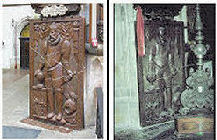
Losing part of his nose in a rapier duel, he was said to have worn a realistic replacement made of silver and gold, using a paste to keep it attached. Some people, such as Fredric Ihren and Cecil Adams have suggested that the false nose also had copper. Ihren wrote that when Tycho's tomb was opened in 24 June 1901 green marks were found on his skull, suggesting copper. Cecil Adams also mentions this green colouring which was noted by the medical experts who examined the remains.
Tycho Brahe spent much of his life compiling the world's first truly accurate and complete set of astronomical tables and his work is only the more remarkable as he did so before the invention of the telescope! Brahe's assistant, Johannes Kepler, later used the tables to deduce the laws of planetary motion. In 1628 Kepler published the Rudolphine Tables, a list of remarkably accurate logarithmic astronomical tables based on Brahe's observations and Kepler's subsequent analysis. Above are two views of the tomb of Tycho Brahe at Tyn. Credit: Petr Hadrava
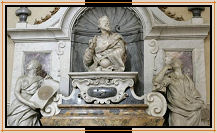
Interestingly, both Tycho and Galileo have recently reappeared in the news: Scientists wish to solve the riddle of Galileo's mistakes using DNA testing ( Source ) "The Italian astronomer -- who built on the work of predecessor Nicolaus Copernicus to develop modern astronomy with the sun as the centre of the universe -- had a degenerative eye disease that eventually left him blind." [ ibid ]

And experts from Denmark have asked the authorities for permission to open and explore the grave of the Danish-born astronomer Tycho Brahe in an attempt to solve the mystery sourrounding his death [ From current events in the Czech Republic Radio Prague ]

In the evening of the 11th of November 1572, Tycho Brahe for the first time sees a new star in the constellation Cassiopeia. After careful observation he publishes his findings about this "new star" or Stella Nova in Latin. Above is his own drawing of Cassiopeia, with the position of the new star/supernova ( red arrow ) shown, the "Nova Stella" marked as "I". [ Credit: Tycho Brahe's Observations ]
The instruments of Tycho Brahe [17]
"The instruments were built by Tycho Brahe and his staff between the 1570's and his death in 1601, many of them during his stay on the island of Hven (between 1576 and 1597). All of Tycho Brahe's instruments are lost. After his death they were kept in a cellar, where they were destroyed during the uprisings in Prague in 1619." From Astronomiæ instauratæ mechanica Tycho Brahes astronomical instruments Website of The Royal Library, Copenhagen

Sextans Chalybeus Pro Distantiis Per Unicum Obeservatrem Dimetiendis Steel sextant for measuring distances by one single observer Credit: ImgBibCC

Semicirculus Magnus Azimuthalis Great semicircular azimuth Credit: ImgBibCC

Quadrans Mediocsis Orichalcicus Azimuthalis Medium sized Azimuth quadrant of brass Credit: ImgBibCC
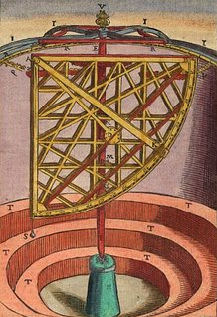
Quadrans Volubilis Revolving azimuth quadrant Credit: ImgBibCC
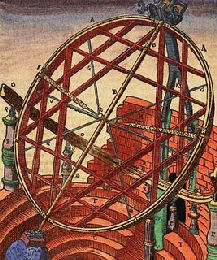
Armilae Aeqatori? Maxim? Sesquialtero Constantes Circulo The great equatorial armillary instrument with one complete circle, and one semicircle Credit: ImgBibCC
Reference Sources of Interest —

Bojan Pancevski in Vienna Hamlet may have poisoned stargazer Tycho Brahe in mercury murder From the TimesOnLine website

Tynsky Chram
One of Prague's most easily-recognizeable landmarks, Tyn Cathedral also houses the tomb of Tycho Brahe, the Danish astronomer who died under mysterious circumstances while in the services of Emperor Rudolph II in 1601.

The Collected Noses of Tycho Brahe by J. R. Salling This short, one page article is a very interesting, humorous and fresh aside on the demise of Tycho's nose; well worth the reading.

Galileo's Instruments of Credit Telescopes, Images, Secrecy Introduction From Brass Instruments to Textual Supplemnts [Copyrighted material published on the internet is currently under fair use notice with exceptions] This is an excellent writing from Mario Biagioli's book

The Galileo Project An excellent study source on Galileo, Kepler, Tycho and other eariler astronomers and scientists
You can:
2. Step Back One Page
3. Jump to the Index Page
4. See Galaxies
5. Read About Stars
6. Return to the Top of this Page